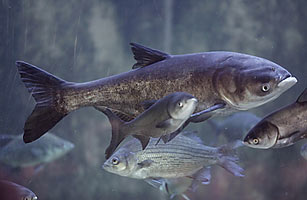
There’s an illegal immigrant cruising its way up the Mississippi River. The Asian carp — a common name for a few separate but similar species of carp — was imported into the U.S. by Midwestern fish farmers in the 1970s. The fish fit perfectly into their native Chinese and Vietnamese habitats, where they’ve been raised in rice fields for more than 1,000 years. But in the U.S., floods allowed Asian carp to escape into the wild, where they quickly proliferated in the Mississippi River system, seizing food and space from outmatched native species. Voracious eaters, the silver Asian carp can grow to as much as 100 lbs. — and they have a habit of launching like missiles at the sound of a motor, braining unwary water skiers and boaters. Now the carp are on the borders of Lake Michigan, and scientists worry that if the fish establish themselves they could ruin the Great Lakes.
The threat is considered dire enough that the Obama Administration has spent nearly $80 million on Asian carp control — money that is overseen by an actual Asian carp czar. The Great Lakes states have filed federal lawsuits to force the Army Corps of Engineers to step up its anti-carp measures, while the shipping industry in Illinois has fought back against the Corps’ plans to possibly shut the Chicago canal to keep out the fish. There’s even an annual carp-hunting tournament held in the small town of Bath, Illinois, where the objective is to kill as many of the fish as possible — while in costume and hopefully while drunk.
Though the concern about the carp is rooted in fact, there’s also an element of xenophobia to the big public reaction to the fish. Not only are Asian carp possibly dangerous, they’re an alien, invasive species. Quite simply, they shouldn’t be there. Invasive plants and animals are viewed as the enemy of nature, outsiders that wreck the balance of the environment and muscle out beloved native species. It has increasingly become the job of biologists and wildlife officials to root out the invaders and protect nature as it was meant to be; the U.S. Fish and Wildlife Service now spends more than $15 million on invasive control just in national wildlife refuges. “This whole native versus non-native dichotomy has really become established,” says Mark Davis, a biologist at Macalester College. “Intended or not, that has become the dogma.”
But a growing number of conservation biologists are beginning to question that conventional wisdom. In a commentary published in the journal Nature last week, Davis and 18 other ecologists called for a reexamination of the default dislike of invasive species. Their argument was simple: in a world where climate change, human population growth and globalization have fractured the environment and scattered so many species, the division between native and non-native seems more and more artificial. “The native versus non-native narrative is a comforting one, and it’s proven successful in the past,” says Davis. “But it’s a 20th century concept that is losing its meaning now that we know every corner of the planet is affected by humans.”